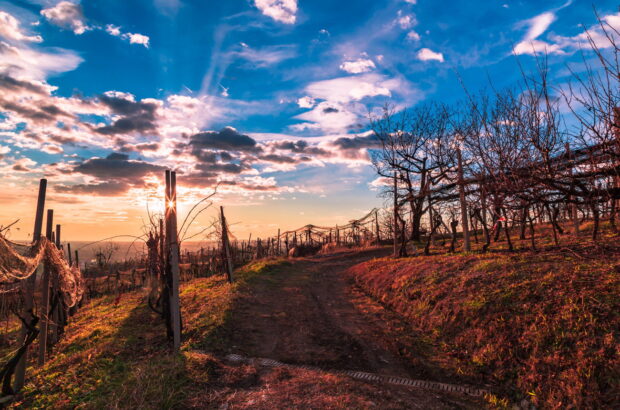The third Thursday in November used to be a date of note in the oenophile’s diary. Since 1985, it had been decreed as the official release date of Beaujolais Nouveau, an annual cause for celebration of the fruity, purple-tinged debutante.
The heyday of Beaujolais Nouveau has long since passed but at the higher-quality end of of the Beaujolais spectrum – Beaujolais-Villages and, in particular, Cru Beaujolais – improving wine quality (and increased recognition for it) is no less cause for celebration.
When the results of this year’s Decanter World Wine Awards (DWWA) were analysed, two Best in Show Beaujolais winners were revealed. The last time this region won a Best in Show was in 2022, for a Cru Fleurie.
This year there was also a Platinum winner and three Golds – an impressive medal haul, and one that builds on last year’s performance of three Gold medals. ‘This year’s double appearance (in a year when no red from further north in Burgundy came through the judging rounds) marks a step forward for this ever-more-significant wine region’, pronounced the judging panel.
Scroll down to explore Beaujolais’ top-awarded wines from DWWA 2024
Factors driving success
So what lies behind the success of this region? There are a number of factors, believes Dominique Vrigneau, Regional Chair for Beaujolais.
Looking back, Vrigneau recalls ‘the banana-y, Beaujolais Nouveau-style wines of 20 years ago’ – a flavour profile that was the result of carbonic maceration, traditional in this region, and that in some part came signify the quantity-before-quality style that caused lasting damage to Beaujolais’s reputation.
‘The sales gradually became worse and worse, and a lot of winemakers left production,’ he explained. ‘So now we have a lot less produced.’ Current vineyard area stands at about 14,500ha according to Inter-Beaujolais, down from a high of 23,000ha in the 1980s.
The second factor is that the (quality-focused) producers still in the game have migrated to the best terroirs in the region. ‘The lower, sandier soils have been taken out of production, so the selection you have now is from better soils’ – often on the higher, granitic-based slopes, said Vrigneau.
That change has brought another factor into play: ‘If you go to Beaujolais and look at the vineyards, you’ll see it’s all being trellised now.’ as vignerons move away from the traditional gobelet training system. Trellising is better suited to the steeper slopes, and makes it easier to spot rot and more easily assess grape quality come harvest-time.
The fourth factor has to do with what takes place in the winery. ‘Very few people do carbonic maceration now,’ Vrigneau says. ‘I know that you read about Beaujolais and carbonic maceration in all the books, but now it’s mostly Burgundy-type maceration.’
The fifth factor? ‘Global warming. There is no longer any chaptalisation required in Beaujolais.’
Another change has less to do with the physical aspects and all to do with mindset: a generation of quality-attuned, well-travelled younger winemakers who recognise the region’s potential and aren’t afraid of change.
Vrigneau describes these changes as ‘a convergence with Burgundy’ – and that convergence extends to price. ‘There have been gradual, incremental improvements to the point that, today, Beaujolais is highly in demand, but the prices are going up – quite a lot’ Vrigneau sums up.
True to the Crus
To anyone who hasn’t tasted (or purchased) Beaujolais lately, these changes may come as a surprise. What’s less surprising about this year’s DWWA results is that all six of the Best in Show, Platinum and Gold winners are Beaujolais Crus, from the hilly northern part of the region, just south of Mâcon.
Among the Best in Show, Platinum and Gold awards, six of the ten Beaujolais Crus are represented – Morgon, Moulin-à-Vent, Juliénas, Brouilly, Régnié and Côte de Brouilly. Those results suggest that wines from the ten standout villages undoubtedly deserve their reputation for quality.
As it happens, both Best in Shows, one from Morgon, the other from Moulin-à-Vent, are from the same producer, Domaine de Colonat. ‘When Morgon is on song, there is no Beaujolais Cru that can match it for exuberance and seductiveness of perfume – and this dark purple-black wine is a splendid example of that astonishing charm,’ said the judges about Domaine de Colonat, Les Charmes, Morgon 2023 (97 points).
The hand-harvested fruit comes from vines from the ‘Les Charmes’ climat that have an average age of 50 years old and are grown on sandy granitic soils, which helps to mitigate Gamay’s vigour and ramp up their seductive character. A relatively small proportion (20%) spends eight months in oak, the remainder in concrete.
Also scoring 97 points was joint Best in Show winner Domaine de Colonat, Les Grenèriers, Moulin-à-Vent 2023. The vines are 62 years old, grown on clay-rich alluvial granite, the grapes hand-harvested. About 30% of the blend spends eight months in oak.
Although these two wines come from the same vintage and producer, stylistically they are very different. ‘It’s not quite as dark in colour and is far less fruit-dominated on the nose. The fruits suggest plum and damson rather than cherry, and there are other more brooding aromatic notes on the nose as well, intimating the wines granite-sand origins’ said the judges.
Winemaker Thomas Collonge is the seventh generation at family-run Domaine de Colonat, and in many ways is typical of the new generation of winemakers in Beaujolais. After studying viticulture and oenology in Beaune, Collonge worked in Châteauneuf -du-Pape in the Rhône, Meursault in Burgundy and in Australia’s Coonawarra. And there’s no carbonic maceration for Collonge’s two Best in Show winners, either.
‘We de-stem the grapes 100%, so we can’t use carbonic maceration’ he explained. ‘We don’t want to extract vegetal tannins. And we regulate the temperature below 25ºC to keep maximum freshness, fruity aromas and fine tannins.’
Collonge also values his older vines (‘We are convinced that the old vines, between 50 to 90 years old, give more concentration and quality to the wine’) and enjoys the challenge of working with the hugely complex mosaic of soil types in the region.
He says: ‘The Beaujolais vineyard brings together a multitude of soils: more than 300 types have been identified, making Beaujolais the French vineyard with the richest and most complex geology. This complexity gives a very interesting challenge to our work.’
Platinum winner Château De Juliénas, Les Brebis, Juliénas 2022 (97 points) was described by judges as ‘Bursting with sumptuous red berries and blueberries enlivened further by a sweep of purple flowers. Sultry and beguiling.’
Representing three further Beaujolais Crus, the three Gold-winning wines (all with 95 points) are Château De La Terrière, Tradition, Brouilly 2023; Domaine De La Bêche, Régnié 2023; and P. Ferraud & Fils, Domaine Rolland, Côte de Brouilly 2022.
A Beaujolais renaissance?
So, is there evidence enough to give credence to talk of a ‘Beaujolais renaissance’? ‘Completely,’ said Dominique Vrigneau. ‘This proves that you can make Gamay very seriously. There is nothing ‘wrong’ with the grape variety, and the wines can be enjoyed in ten years as well.’ So much for the Gamay ‘inferiority complex’.
Looking outside the region, Thomas Collonge also sees signs of Beaujolais’s renewed international image. ‘Over the last five or six years, we really feel that there is a more respected qualitative image of Beaujolais wines in the world. Our style of red wine, with lot of fruit, fine structure, and fresh tasting is the perfect style consumers are looking for.’
The idea of a move away from heavier reds is echoed elsewhere too. A recent wine-trade report indicates that sales of Beaujolais at high-end bars, hotels and restaurants in the UK are going ‘through the roof’ as Brits switch to lighter reds. Meanwhile, producers in Canada are tuning in to Gamay’s pleasures, as are winemakers in Oregon, who are discovering that, grown in the right place, the grape can make ‘hauntingly perfumed and age-worthy wines’.
With Beaujolais – and its foundational grape, Gamay – experiencing a resurgence, there’s a lot to discover in the region. And there’s no need to wait until the third Thursday in November to take part in its pleasures.
DWWA 2024: Beaujolais’ top-awarded wines to try
Best in Show
Domaine De Colonat, Les Charmes, Morgon 2023

97 Best in Show
We’ve only ever featured a Beaujolais cru in our Best In Show selection once (a 2020 Fleurie), so this year’s double appearance (in a year when no red from further north in Burgundy came through the judging rounds) marks a step forward for this ever-more-significant wine region. When Morgon is on song, there is no Beaujolais cru that can match it for exuberance and seductiveness of perfume – and this dark purple-black wine is a splendid example of that astonishing charm. Cherries and plums cascade from the glass. On the palate, it’s no less exuberant: packed with tongue-coating fruit, and with its acidity in turn dripping with fruit sweetness and perfumed flesh. There are light, graceful tannins but nothing else to break the fresh-fruit spell – it’s a very pure wine, aged entirely in concrete, and bottled without any reduction, false or specious notes. Gorgeous drinking. Alcohol 14%
Domaine De Colonat, Les Grenèriers, Moulin-à-Vent 2023

97 Best in Show
You’d expect a Moulin-à-Vent to be very different to this year’s Beaujolais Best In Show from Morgon; indeed it is. It’s not quite as dark in colour, and is far less fruit-dominated on the nose. The fruits it shows, too, suggest plum and damson rather than cherry, and there are other more brooding aromatic notes on the nose as well, intimating the wines granite-sand origins; you might, finally, find a meatiness there. On the palate, this is as intense as the Morgon but, once again, more complex and layered, with fruit, stone and other savoury notes. The acidity, though, is admirably juicy, and the tannins remain palpable and shaping though soft. This is a serious cru wine which wears its authority lightly. Alc 14%
Platinum
Château De Juliénas, Les Brebis, Juliénas 2022

97 Platinum
Bursting with sumptuous red berries and blueberries enlivened further by a sweep of purple flowers. Sultry and beguiling on the palate with lingering mineral notes and a delectable texture. Hugely fresh with an enduring, vibrant finish. Alc 14%
Gold
Château De La Terrière, Tradition, Brouilly 2023

95 Gold
Lashings of delicious red fruits and fragrant herbs with an enduring purity and freshness. Fleshy and juicy with well-defined tannins and a pepper spice grip on the finish. Alc 13.5%
Domaine De La Bêche, Régnié 2023

95 Gold
Brimming with vibrant raspberry and redcurrant fruit which cascades across the nose and palate and melts into the spicy tannins and linear acidity. Lovely and long. Alc 13%
P. Ferraud & Fils, Domaine Rolland, Côte de Brouilly 2022

95 Gold
A charming flourish of aromatic florals enveloped in sleek black fruits, with a lustrous texture and bracing crunch of acidity. Supple and joyous with a delightful finish. Alc 13%






